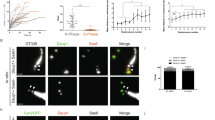Abstract
Multiciliated cells (MCC) display on their apical surface hundreds of beating cilia that propel physiological fluids. They line brain ventricles where they propel the cerebrospinal liquid, airways where they clear mucus and pathogens and reproductive ducts where they concentrate the sperm in males or drive the egg along the oviducts in females. Motile cilia are nucleated from basal bodies which are modified centrioles. MCC therefore evade centriole archetypal duplication program to make several hundreds and nucleate an identical number of motile cilia. Defects in this centriole amplification process lead to severe human pathologies called “ciliary aplasia” or “acilia syndrome” and more recently renamed “reduced generation of motile cilia” (RGMC). Patients with this syndrome present frequent hydrocephaly, lung failure, and subfertility. In this manuscript, we describe the protocol we developed and optimized over the years to live image the centriole amplification dynamics. We explain why mouse brain MCC is a good model and provide the tips to enable successful spatially and temporally resolved monitoring of this massive organelle reorganization.
Access this chapter
Tax calculation will be finalised at checkout
Purchases are for personal use only
Similar content being viewed by others
References
Al Jord A, Lemaître A-I, Delgehyr N, Faucourt M, Spassky N, Meunier A (2014) Centriole amplification by mother and daughter centrioles differs in multiciliated cells. Nature 516(7529):104–107. https://doi.org/10.1038/nature13770
Mercey O, Al Jord A, Rostaing P, Mahuzier A, Fortoul A, Boudjema A-R, Faucourt M, Spassky N, Meunier A (2019) Dynamics of centriole amplification in centrosome-depleted brain multiciliated progenitors. Sci Rep 9(1):13060. https://doi.org/10.1038/s41598-019-49416-2
Al Jord A, Shihavuddin A, Servignat d’Aout R, Faucourt M, Genovesio A, Karaiskou A, Sobczak-Thépot J, Spassky N, Meunier A (2017) Calibrated mitotic oscillator drives motile ciliogenesis. Science 358(6364):803–806. https://doi.org/10.1126/science.aan8311
Reiter JF, Leroux MR (2017) Genes and molecular pathways underpinning ciliopathies. Nat Rev Mol Cell Biol 18(9):533–547. https://doi.org/10.1038/nrm.2017.60
Nigg EA, Holland AJ (2018) Once and only once: mechanisms of centriole duplication and their deregulation in disease. Nat Rev Mol Cell Biol 19(5):297–312. https://doi.org/10.1038/nrm.2017.127
Higginbotham H, Bielas S, Tanaka T, Gleeson JG (2004) Transgenic mouse line with green-fluorescent protein-labeled centrin 2 allows visualization of the centrosome in living cells. Transgenic Res 13(2):155–164. https://doi.org/10.1023/B:TRAG.0000026071.41735.8
Yamamoto S, Yabuki R, Kitagawa D (2021) Biophysical and biochemical properties of Deup1 self-assemblies: a potential driver for deuterosome formation during multiciliogenesis. Biol Open 10(3):bio056432. https://doi.org/10.1242/bio.056432
Delgehyr N, Meunier A, Faucourt M, Bosch Grau M, Strehl L, Janke C, Spassky N (2015) Ependymal cell differentiation, from monociliated to multiciliated cells. Methods Cell Biol Elsevier 127:19–35. https://doi.org/10.1016/bs.mcb.2015.01.004
Author information
Authors and Affiliations
Corresponding author
Editor information
Editors and Affiliations
Rights and permissions
Copyright information
© 2024 The Author(s), under exclusive license to Springer Science+Business Media, LLC, part of Springer Nature
About this protocol
Cite this protocol
Boudjema, AR. et al. (2024). Live-Imaging Centriole Amplification in Mouse Brain Multiciliated Cells. In: Mennella, V. (eds) Cilia. Methods in Molecular Biology, vol 2725. Humana, New York, NY. https://doi.org/10.1007/978-1-0716-3507-0_10
Download citation
DOI: https://doi.org/10.1007/978-1-0716-3507-0_10
Published:
Publisher Name: Humana, New York, NY
Print ISBN: 978-1-0716-3506-3
Online ISBN: 978-1-0716-3507-0
eBook Packages: Springer Protocols




